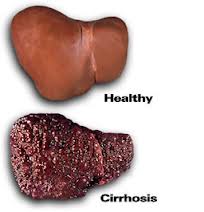
Cirrhosis of the liver is among the most dangerous of all liver diseases. It is progressive, debilitating, and potentially deadly. It consists of scarring of the liver tissue and the development of fibrous growths that interfere with liver function. As the disease progresses, the liver suffers increasingly serious damage and loss of function, until in the final stage it has become unable to do its vital tasks and the prognosis is terminal. If the disease progresses to its final stage (stage 4), it is in every case fatal unless aggressively treated.
Causes
Cirrhosis has a number of possible causes. The most common cause is alcohol abuse, but cirrhosis can also develop as a result of obesity, diabetes, a progression from other liver diseases such as hepatitis or even the relatively innocuous fatty liver disease, or as a result of autoimmune disorders, cystic fibrosis, or hereditary factors.
With many liver diseases, including cirrhosis, a distinction is made between alcoholic and non-
There are several significant risk factors for developing cirrhosis of the liver. The most important of these are alcohol abuse or alcoholism, obesity, and type II diabetes.
Symptoms
Cirrhosis of the liver is often lacking in symptoms in its early phases, developing overt symptoms only as it progresses and becomes more severe. When symptoms do appear, at whatever point in the disease’s progression, they typically include chronic fatigue, abdominal swelling or inflammation, jaundice (yellow color to the skin and the whites of the eyes), chronic thirst and dry mouth, and the development of patches of discolored skin.
Usually, the first indication of cirrhosis is none of these symptoms but rather a blood test indicating elevated liver enzymes. This however is not a certain test for cirrhosis, since it can indicate any number of liver diseases and also can arise from other factors when the liver is not afflicted at all. When elevated liver enzymes appear in a blood test, therefore, follow-
A biopsy (removing a small sample of liver tissue for analysis) can provide a final diagnosis of cirrhosis of the liver, or of certain other liver conditions such as cancer. This is not a risk-
Stages
Cirrhosis of the liver is a progressive disease that becomes worse over time. Doctors recognize four stages of the disease. Continued below….
Stage 1
In the first stage, the disease is usually asymptomatic, or it may have mild symptoms. Medical imaging reveals abnormal tissue growths and inflammation of the liver.
Stage 2
In stage two, the abnormal tissue growth found in stage one becomes hardened and fibrous, a condition known as “fibrosis,” which may also occur outside the context of cirrhosis. At this point, some loss of liver functioning is usually found, although not sufficient to seriously threaten health or life.
Stage 3
In stage three, the fibrous tissue found in stage two has spread until it is found all through the liver. Patches of it have begun to merge into large inflamed regions, and liver functioning begins to be significantly impaired. Overt symptoms usually appear. These often rise from impairment of the body’s ability to digest fats (which is a primary liver function), not just fat metabolized for calories, but more importantly
the digestion of fatty acids and fat-
Stage 4
In the final stage, stage four, the damage found in stage three has progressed further to severe impairment of liver function and a terminal prognosis. At that point, a liver transplant has become a necessity of survival.
Is Cirrhosis Of The Liver Reversible?
Unlike some other liver diseases, cirrhosis of the liver is not reversible. The progression of the disease may be arrested with appropriate treatment if it is detected in the early stages, but damage caused by the disease remains and does not heal. The key to treatment, therefore, is early detection and reversal of the factors causing the illness before the damage becomes serious.
Treatment
In the final stage, the only treatment for cirrhosis of the liver is a liver transplant. In earlier stages, though, treatment aims to arrest the progression of the disease so that it never reaches stage four. This requires identifying the cause of the illness correctly. If the disease arises from alcohol abuse, cessation of drinking is (obviously) indicated. If it is due to obesity, a program of diet and exercise aimed at gradual weight loss is appropriate. Other causes of cirrhosis of the liver may require other approaches, but in all cases the treatment involves reversing the factor that is causing the damage to the liver.
In fact, all of the causes of cirrhosis have other negative impacts on health as well. One could therefore expect a significant improvement in overall health from successful treatment of early stage cirrhosis.